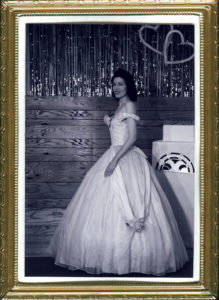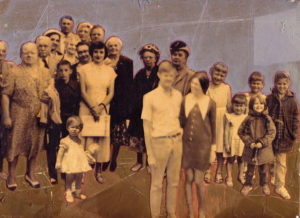
Me (Mother and Me Series), Elizabeth DiGiovanni, silver gelatin print in vintage frame
![]()
Going Home Again presented work by two artists who explore memory, childhood, and inheritance.
In her work, Elizabeth DiGiovanni struggles for a sense of connection. She collects, like her mother and grandmother before her, as if working to preserve fragmentary traces of some lost significance, and trying to inherit not only artifacts but also the very practice of collecting as if it were a tradition. She over-identifies with her mother by presenting her mother’s work as her own, and recreating images of her mother with herself in her mother’s place. Something obscene about this identification speaks to both the difficulty of their relationship and the desperation with which DiGiovanni struggles to belong. She confuses the personal and the public, putting private remembrances on open display; and she relishes in kitsch nostalgia that haunts in its syrupy-sweetness. Her work is riddled with melancholy that manifests itself in the pathetic finitude of the particular artifacts she preserves from the past—Christmas cards, spools of thread, and a coconut-frosted cake cut in the shape of a lion with licorice for legs.

Family Reunion, Monica Johnson, oil and collage on canvas
Monica Johnson constructs scenes that tell stories, both within individual pieces and in the connections drawn between different works. In one series of paintings in this show, she presented episodes from her childhood with the recurrent figure of a wrinkled, bloated, moon face—perhaps a stand-in for the artist herself—which appeared both infantile and ancient. This repeated image gave the paintings a surreal quality, evoking the nagging uncertainty of what happened in the past and what it meant, along with the sense of estrangement suffered in childhood. The paintings were connected by pencil drawings on the walls which included diary entries—some visible, some erased—that embellished the scenes as associations; while other paintings included text within them like frames from a graphic novel. And Johnson returned repeatedly in this work to maps, as if she were trying to designate landmarks along the path of her upbringing and to give coherence to what seems so familiar and yet menacingly unclear.